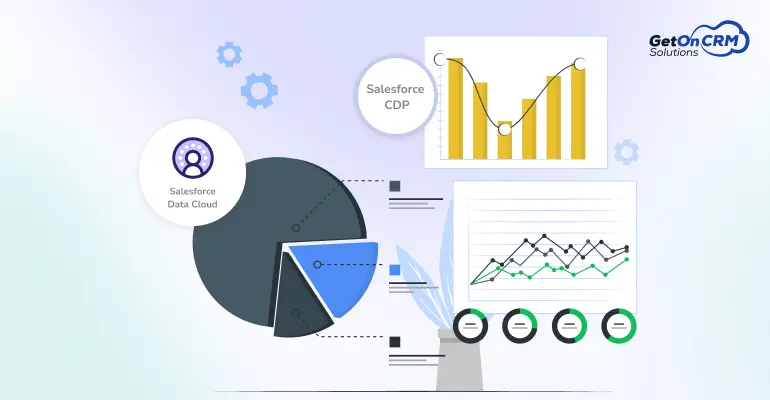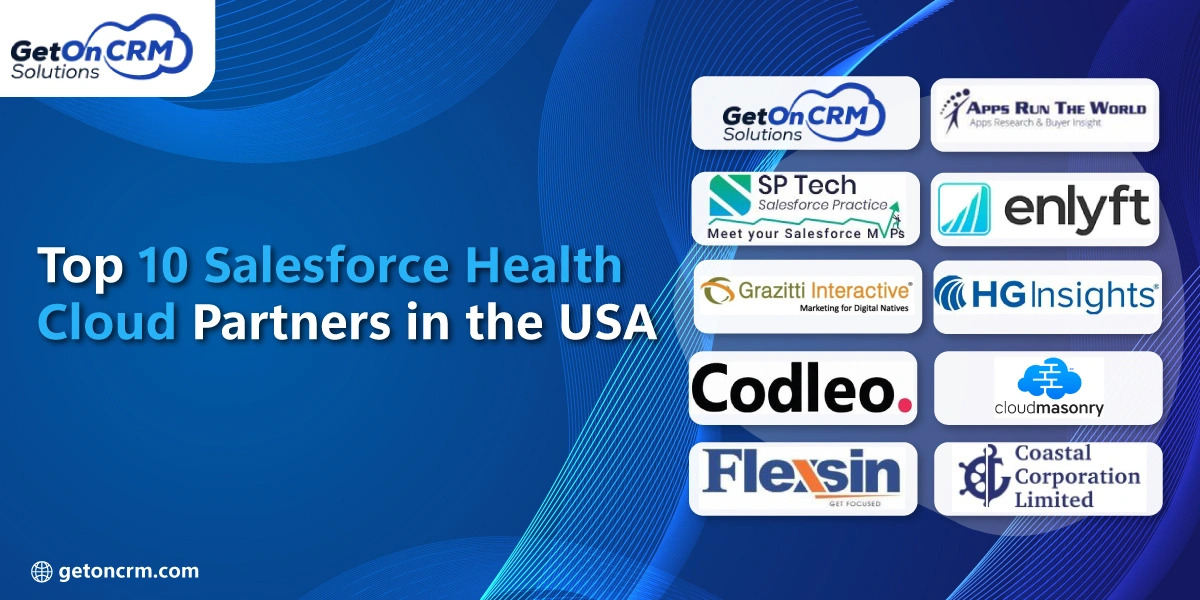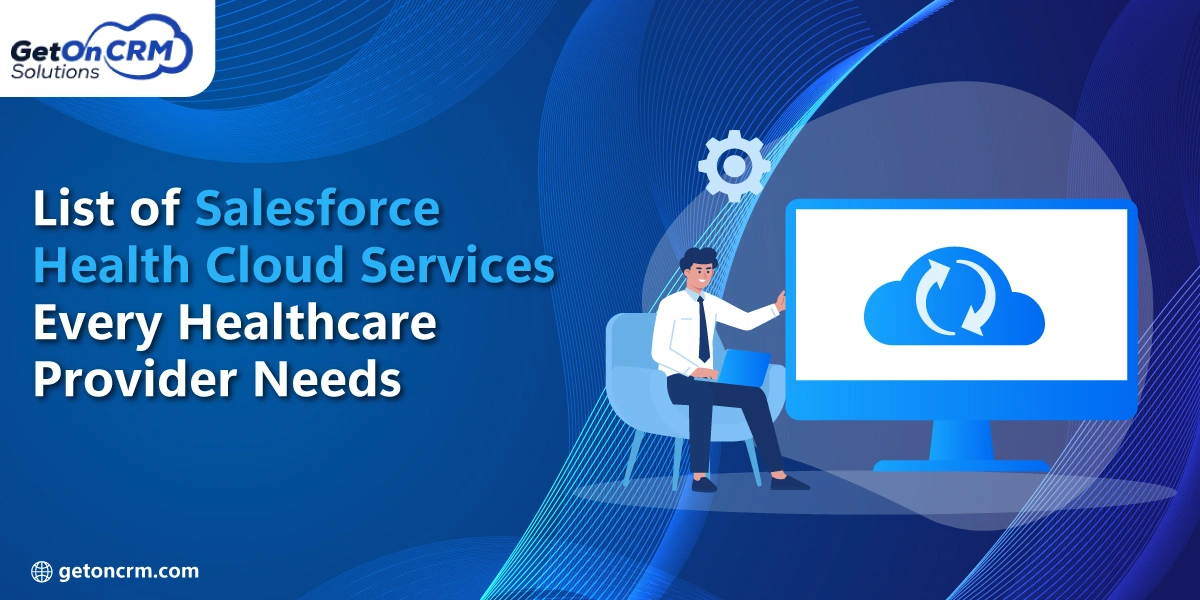Effective customer data management has become an essential element for businesses seeking to enhance customer experiences and drive growth. Organizations collect vast quantities of customer data across various channels; the challenge lies not simply in collecting this information but in making it actionable. Salesforce Data Cloud and Customer Data Platforms (CDPs) offer robust solutions that unify and activate this customer information across various touchpoints.
This blog will outline how Salesforce Data Cloud, combined with a CDP, can assist businesses in making the most of their customer data. We will discuss its key benefits, common challenges, and best practices for using these tools to create tailored experiences, better decision-making processes, and sustainable growth.
What Is A Salesforce Customer Data Platform and How Does It Work?
The Salesforce CDP is defined as an in-built software system that aids in collecting, organizing, assembling, and centralizing each customer’s data. Further, the platform helps to build complete fledged customer profiles. This platform combines marketing automation, customer database, real-time management and customer database. It is helpful when you need marketing information with user-level data.
The CDP will leverage the first-party data that can further be improved with third-party data. It offers centralized solutions, which aid the business in storing user data in a single place. Moreover, you can access customer data and information and implement personalized or customized strategies for marketing in multiple channels.
The primary working process of the CDP is to gather and unify first-party customer data from various sources to build a complete structural view of each customer and their journey. The data is further available to marketers to create targeted marketing campaigns. It is helpful to develop a hyper-personalized customer experience by viewing the customer profile.
What is Salesforce Data Cloud?
Salesforce Data Cloud is a powerful platform designed to assist businesses with unifying and managing customer data across all touchpoints. By unifying data from various sources, such as sales, service, marketing, commerce, etc, into one comprehensive view of customers, Salesforce Data Cloud enables businesses to understand customers better and deliver more tailored, relevant experiences for each one.
Why They Work Well Together
Integrating Salesforce Data Cloud and CDP creates a potency combination for customer data management. While Data Cloud collects and harmonizes information from multiple sources, CDP allows businesses to activate and analyze it effectively for customer profiles – essential in providing personalized experiences and making intelligent business decisions.
Key Benefits of Integrating Salesforce Data Cloud with CDP
Integrating Salesforce Data Cloud with a CDP helps businesses bring all their customer data together in one place, making it easier to create detailed customer profiles and deliver personalized experiences.
Unified Customer Profiles
Creating unified customer profiles is one of the significant advantages of combining Salesforce Data Cloud with a CDP. By combining information from multiple sources, companies may get a comprehensive picture of customers – including interactions, preferences, and behaviors – giving them a comprehensive picture that allows for tailoring experiences specifically to each person’s needs.
Enhanced Personalization
By creating unified customer profiles, businesses can deliver highly tailored experiences across all touchpoints. From specialized customer service encounters and product recommendations to focused marketing efforts and customized service support – Salesforce Data Cloud and CDP integration ensures each interaction is relevant and meaningful – leading to improved customer satisfaction and loyalty.
Improved Data Activation
Data activation refers to the process of making customer data actionable. By integrating Salesforce Data Cloud with a CDP, businesses can easily segment their target audiences, trigger automated workflows, and deliver personalized content in real-time – ensuring customer data is not just collected but actively utilized for driving business outcomes.
Scalability and Flexibility
As businesses expand, their data needs become more complex. Businesses can handle massive amounts of data with the scalability and flexibility that Salesforce Data Cloud and CDP provide, adding new sources rapidly when needed – helping companies to meet customer expectations without being limited by their data infrastructure.
Addressing Common Challenges
While integrating Salesforce Data Cloud with a CDP offers significant advantages, businesses often face challenges like data silos and complex data integration processes.
Data Integration Issues
The process of integrating data from several sources can be difficult and time-consuming. Different systems often store data in other formats, making it challenging to create a unified view. In order to overcome this difficulty, Salesforce Data Cloud offers smooth connectivity with a range of data sources, guaranteeing that all customer data is unified and available from a single platform.
Usability and Accessibility
One of the barriers to effective data management is the usability of the tools involved. If only technical teams can access and use the data, it limits the potential benefits. With user-friendly interfaces that make it simple for non-technical individuals to access and utilize customer data, Salesforce Data Cloud and CDP are developed with usability in mind.
Breaking Down Silos
Data silos occur when different departments within a business have access to other sets of data, preventing a cohesive understanding of the customer. Integrating Salesforce Data Cloud with a CDP helps break down these silos by centralizing data in one place, making it accessible across the organization. That not only improves collaboration but also ensures that all teams are working with the same, up-to-date customer information.
Business Benefits of Integrating Customer Data Platform and Data Cloud
The synergy between a Customer Data Platform and Salesforce Data Cloud provides businesses with a comprehensive understanding of their customers.
Enhanced Customer Insights
By integrating a Customer Data Platform (CDP) with Salesforce Data Cloud, businesses can achieve a comprehensive view of their customers. This 360-degree view provides deeper insights into customer behaviors, preferences, and trends, enabling more informed decision-making. Businesses can use these insights to develop products, services, and marketing strategies that better meet customer needs.
Personalized Customer Experiences
The integration of CDP and Salesforce Data Cloud allows businesses to deliver highly personalized experiences across all customer touchpoints. With unified customer profiles, companies can tailor their communications, offers, and services to individual customers, increasing engagement and fostering long-term loyalty.
Operational Efficiency and Cost Reduction
Integrating CDP with Salesforce Data Cloud streamlines data management processes by eliminating data silos and reducing the need for complex integrations. That not only improves operational efficiency but also reduces costs associated with data duplication, custom development, and system maintenance.
Improved Marketing and Sales Performance
Teams in charge of marketing and sales can develop more focused and successful campaigns when they have access to unified data. Businesses may react more swiftly to consumer demands and market trends when real-time data activation is implemented, which boosts conversion rates and income.
Scalability for Business Growth
As businesses grow, their data needs expand. The combination of CDP and Salesforce Data Cloud provides the scalability needed to handle larger data volumes and integrate new data sources seamlessly. It ensures that businesses can continue to meet customer expectations as they expand.
Future-Proofing the Business
Businesses are better positioned to adjust to future changes in customer behavior and market conditions because of the incorporation of cutting-edge technologies like AI and machine learning into Salesforce Data Cloud and CDP. Companies can preserve a competitive advantage in a world that is becoming more and more data-driven by staying ahead of the curve.
Real-World Business Impact
The integration of Salesforce Data Cloud with a Customer Data Platform (CDP) has demonstrated significant business impacts across various industries. Let’s look at some actual instances of businesses using these technologies to achieve quantifiable success.
Aston Martin
Aston Martin utilized Salesforce Data Cloud to consolidate customer data from initial inquiries to car delivery, assembling a thorough, three-dimensional picture of their customers. This unified data allowed their dealership sales teams to deliver highly personalized interactions and gain deep insights into high-value customers. The result was a more tailored customer experience, which significantly improved customer satisfaction and loyalty.
Turtle Bay Resort
Turtle Bay Resort integrated Salesforce Data Cloud to unify guest data, including booking history and resort interactions, into a single profile. This 360-degree view enabled the resort to offer hyper-personalized experiences from pre-booking through post-stay. As a result, the resort saw an increase in customer engagement, a boost in booking conversions, and improved concierge efficiency, ensuring that guests return year after year.
Air India
Air India leveraged Salesforce Data Cloud to unify their customer data across loyalty programs, reservations, and web browsing history. This comprehensive view of each passenger enabled Air India’s agents to be more productive and deliver consistent, high-quality service. The integration led to a notable increase in service efficiency and helped the airline maintain a high level of customer satisfaction.
Mascoma Bank
Mascoma Bank used Salesforce Data Cloud to streamline dozens of legacy systems into a single platform, providing bankers with a 360-degree view of their customers. This integration reduced call center hold times and accelerated loan processing, significantly enhancing operational efficiency and customer service quality.
Final Thoughts
Combining Salesforce Data Cloud with a Customer Data Platform (CDP) is a powerful way for businesses to improve how they manage customer data. By bringing together data from different sources into one platform, companies can make the most of their customer information, leading to more personalized and effective interactions. This approach not only creates better customer experiences but also helps businesses work more efficiently, grow, and stay competitive.
At GetOnCRM Solutions, a Salesforce Ridge consulting partner, we help businesses take full advantage of Salesforce Data Cloud and CDP integration. Our team is here to ensure you get the most out of your customer data, allowing you to improve engagement, streamline operations, and prepare for the future.
Frequently Asked Questions on Salesforce Data Cloud CDP Implementation
What is Salesforce Data Cloud CDP used for?
Salesforce Data Cloud CDP centralizes customer data from multiple sources. It creates a single, accurate customer profile businesses can use for personalized marketing, sales, and service strategies.
How does CDP improve customer engagement?
By unifying customer data, CDP allows businesses to understand preferences, behaviors, and purchase history. This leads to personalized interactions and better engagement across channels.
Can Salesforce Data Cloud integrate with third-party apps?
Yes. Data Cloud connects with multiple data sources and platforms. This flexibility ensures businesses can gather and analyze information from all customer touchpoints.
How does CDP support compliance and data security?
Yes. Data Cloud connects with multiple data sources and platforms. This flexibility ensures businesses can gather and analyze information from all customer touchpoints.
Is Salesforce Data Cloud CDP suitable for small businesses?
Yes. Small businesses can use CDP to consolidate fragmented customer data. It helps them deliver personalized service and compete effectively with larger organizations.
How does CDP improve marketing performance?
By giving marketers a 360-degree customer view, CDP allows for accurate targeting, reduced ad waste, and better campaign performance. Businesses can build stronger customer relationships while saving money.





















